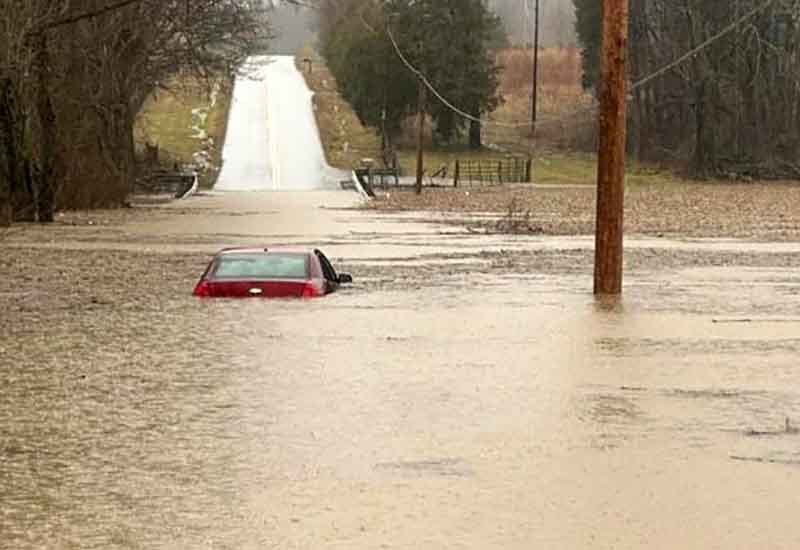- 10 fatalities reported across Southeast US due to severe storms.
- Kentucky suffers the highest toll with 9 confirmed deaths.
- Thousands of rescues carried out, power outages affecting 39,000 homes.
- Flash floods and tornadoes wreak havoc in Mississippi, Tennessee, and Arkansas.
- Major snowfall and ice storms predicted in Northeast US
A deadly storm system lashed the Southeast U.S. over the weekend, bringing heavy rain, floods, and destructive winds. At least 10 people have been confirmed dead as a result of the severe weather, with Kentucky bearing the brunt of the devastation.
On Sunday (16 February), Kentucky Gov. Andy Beshear confirmed that the state had suffered at least nine storm-related deaths, including a tragic incident in which a mother and her 7-year-old child drowned in their car after being trapped by rising floodwaters. Beshear expressed concern that the death toll might rise as rescue operations continued.
“This is the search and rescue phase, and I am very proud of all the Kentuckians out there putting their lives on the line,” Beshear said in a press conference.
By Sunday, more than 1,000 rescues had been carried out across Kentucky. However, the storms had knocked out power for nearly 39,000 homes, and Beshear warned that the situation could worsen due to expected strong winds.
A 73-year-old man was found dead in floodwaters in Clay County, Kentucky, and officials are investigating further deaths in Hart County, where a juvenile was reported dead and another person went missing on Saturday evening. Flooded roads and mudslides have made access to affected areas more challenging.
Widespread Flooding and Tornadoes Across the Southeast
Flash flooding warnings were issued in Kentucky, Tennessee, West Virginia, and Arkansas, with rainfall of up to 8 inches reported in some regions. The National Weather Service urged residents to stay off the roads due to hazardous driving conditions.
Elsewhere in the Southeast, tornadoes struck Mississippi and Alabama on Saturday night, leaving behind widespread damage. In Mississippi, four tornadoes were confirmed, while Alabama reported three. A tornado also touched down in Louisiana, causing further destruction.
In Georgia, a man died when a powerful storm uprooted a tree, which crashed into his home in Atlanta. Rescue teams across the affected states continue to work tirelessly to save those trapped by floods and downed trees.
State of Emergency Declared in West Virginia and Kentucky
On Saturday, West Virginia Gov. Patrick Morrisey declared a state of emergency for 10 southern counties due to ongoing flooding, allowing state resources to assist local authorities.
Meanwhile, Kentucky’s Gov. Beshear preemptively declared a state of emergency in anticipation of more flash floods through Sunday. He also requested federal assistance and disaster funds, writing to the White House for immediate support. In response, the Kentucky River Medical Center in Jackson closed its emergency department, transferring patients to other nearby hospitals.
Northern U.S. Braces for Snow, Ice, and Cold Front
In addition to the storms in the Southeast, northern parts of the U.S. faced their own weather challenges, with heavy snowstorms expected in the Northeast and Upper Midwest.
Upstate New York and northern New England were predicted to receive up to a foot of snow, followed by sleet and freezing rain, making travel nearly impossible.
The National Weather Service also issued warnings for severe winter weather across the Midwest, with up to 4 inches of snow expected in parts of Iowa, Wisconsin, and Michigan by Sunday evening.
In the Rocky Mountains, temperatures plummeted as low as 14°F, prompting the opening of shelters for those living on the streets in Denver. Skiers also faced closures on mountain roads due to hazardous conditions caused by heavy snow.
California Struggles with Aftereffects of Powerful Storm
Southern California saw a return to dry weather, but the risk of mudslides continues, particularly in areas scarred by wildfires. On Thursday night, water and debris rushed down the mountain in Sierra Madre, trapping cars and damaging homes. In Mammoth Mountain, a massive snowstorm dumped 6 feet of snow in just 36 hours, and two ski patrol staff were caught in an avalanche, with one being taken to the hospital with serious injuries.
As the storm system continues to affect regions across the U.S., emergency officials urge citizens to stay vigilant. The devastation left in the wake of these severe weather events is a stark reminder of nature’s unpredictable power and the importance of preparation and caution during such extreme conditions.


